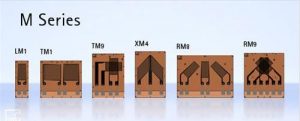 Strain gauges from Durham Instruments offer high resistance to alternating loads
Strain gauges from Durham Instruments offer high resistance to alternating loads
March 18, 2016 REDWIRE is news you can use from leading suppliers. Powered by FRASERS.
Posted by Durham Instruments
One Source For All Your Quantitative Measuring Needs. With Over 50 Yrs.Of Experience In The Instrumentation Field. It Of... Read more
Subscribe
Free REDWIRE e-newsletter

M Series strain gauges from HBM, and available through Durham Instruments, are designed to offer high resistance to alternating loads at increased strain levels and temperatures up to 300 degrees C. Ideal for applications in the aerospace industry, these strain gauges are constructed of foil, and feature measuring grids made of a special nickel-chromium alloy. They are available in a variety of shapes and sizes to meet the exact needs each unique application.
The lineup
HBM has a wide selection of M Series strain gauges. The lineup includes:
- The LM1 model has one measuring grid for strain measurements in one direction.
- The TM1 strain gauge is designed to measure tensile and compressive stress. It is a T rosette with two measuring grids arranged at 90-degree angles.
- Also designed for measuring tensile and compressive stress, the TM9 strain gauge is a stacked T rosette with two measuring grids arranged at 90-degree angles.
- The XM4 variety determines torsion and shear stress. It is v-shaped with two measuring grids arranged at 45-degree angles.
- Model RM8 is a rectangular rosette with three measuring grids arranged at zero-, 45- and 90-degree angles. It measures biaxial stress state with unknown principal stress directions.
- The RM9 strain gauge also measures biaxial stress state with unknown principal stress directions; however, this model is a stacked rosette with three measuring grids arranged at zero-, 45- and 90-degree angles.
HBM can also produce customized strain gauges.
Many lengths available
M Series strain gauges are available with different measuring grid lengths — from 1.5 to six millimetres — to meet the needs of various material and space requirements.
For example, long measuring grids are recommended for applications involving materials that are not uniform, such as concrete or wood. Short measuring grids, on the other hand, are suitable for detecting a local strain state, and determining strain gradients (strain gauge chains), the maximum point of notch stresses and similar stresses.
More information
HBM’s M Series strain gauges are available in Canada from Durham Instruments, based in Pickering, Ont. To learn more about the wide selection available, contact Durham Instruments.
Share
Posted by Durham Instruments
One Source For All Your Quantitative Measuring Needs. With Over 50 Yrs.Of Experience In The Instrumentation Field. It Of... Read more
